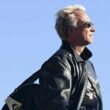By Ruud Vermeij
Often dancers feel the need to show happiness: a syndrome we have adopted from popular culture “one should be happy”. Of course in dance there is a theatrical aspect to it all and part of theatre is illusion, but have we gone too far?
I think it is important to look at happiness as one of many moods which include melancholy, fear and insecurity. It is much more interesting to witness and feel the changing moods in the other than it is to watch this fake happiness.
Don’t we often feel lonely when we are with others or watching dancers? Lonely because real meeting cannot take place when we come up against a wall of pretence.
I would encourage meeting in a direct, honest interpersonal relationship with both your partner and the audience which involves your whole being. Not smiling only as an object or a means to a goal.
The fear of being in real contact is the fear of intimacy. Intimacy requires self reflection of the “in-to-me-I-see” variety.
The smile may hide many complex feelings: fear, sadness, anger, resentment and melancholic ambiguity. Often the pretending is not even known to the pretender. When really meeting on an intimate level with the other one has to state or make known and accept the impermanence of life; showing not only happiness but also revealing one’s deep self in front of the other, creating a shared reality.
Genuine intimacy requires dialogue, transparency, vulnerability and reciprocity. In dance and life it is the activity of intimating (making known).
Showing the glitz and glam of fake happiness does not fulfil the self and the other but creates separateness, detachment and objectification. Showing the truth of oneself in revealing the whole self creates intimacy and realness in sharing in art and in life. The beauty of real meeting is like an aesthetic experience: nothing beyond the meeting is desired, the experience cannot be replicated and is felt as an end-in-itself.
The experience involves an appreciation of and a respect for the reality of the other and the self in all its complexity. Dance then reveals more then just the dance. Dance becomes a self portrait of the artist or as Martin puts it to “externalise personal authentic experience”.
Ruud Vermeij










